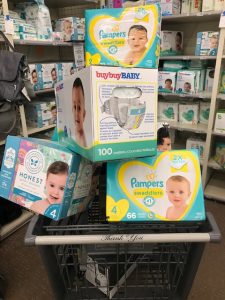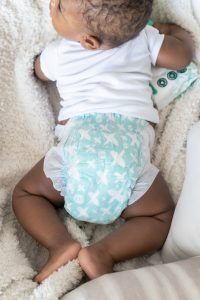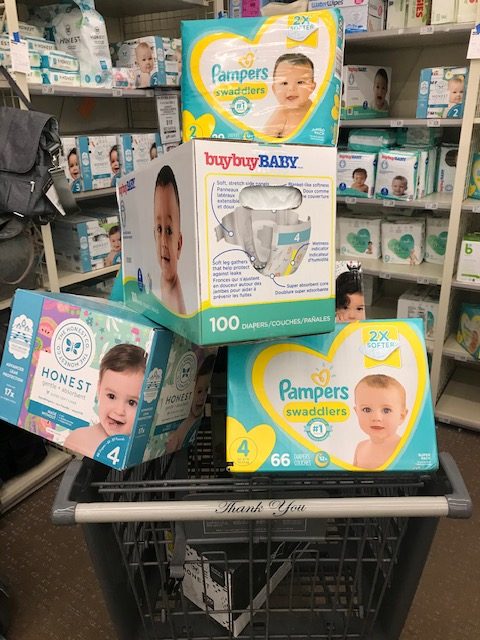
Little ones come with BIG expenses and…disposable diapers can take a giant chunk of the family budget!
In fact, babies typically go through roughly 7,000 diapers from birth to potty training (at around age 2 ½). At an average price of 37 cents per diaper, you can plan to spend roughly $2590 over your baby’s diapering career. Ouch!
BUT…that’s just an average.
“What you’ll spend is going to be very different, depending on the brand of diapers you buy,” says Natalia Richer, director of operations at Diaper Testing International and a diaper and and absorbent hygience products consultant.
Which are the cheapest diapers? Which is the best brand of diapers? Are some disposable diapers more ecofriendly than others?
If you decide to use disposable diapers—like the majority of parents do even though reusable diapers are becoming more mainstream–there’s a lot you can do to cut your diaper costs.
BabyProductsMom talked with Ms. Richer to answer your most pressing questions to help you save dollars on disposable diapers—and more!
Note: This content contains affiliate links to products and services BabyProductsMom believes may be of high quality and value to you.
Which brand of diapers is the cheapest?
NR: The least expensive diapers are Walmart’s Parent’s Choice. Using size 4 diapers as an example, you can find Walmart’s Parent’s Choice diapers for as low as 13 or 14 cents per diaper. (Although you can find Parent’s Choice on Amazon, Walmart offers that low price.)
On the flip side, Healthynest diapers in size 4 may cost as much as 60 cents per diaper.
BPM: Wowza! That’s a big spread–$980 for Parents’s Choice versus $4200 for Healthynest, for the 7,000 diapers you’ll use, on average.
NR: Diapers can also vary widely in cost within a brand, too. You can find Pampers BabyDry and Pampers Swaddlers, for example, for as low as 22 to 24 cents per diaper (size 4). Pampers Pure may cost 43 cents per size 4 diaper.
BPM: And Walmart now offers Rascal + Friends, which retails for around 27 cents to 32 cents per diaper, for size 4, depending on the size box you buy (in general, the greater the diaper count, the lower the cost per diaper).
So, it sounds like if saving money is your biggest goal, you might start with Parent’s Choice to see if they work for your baby. If they don’t work out for some reason, shop around.
NR: Yes, try different brands and see which offers the snuggest fit. Does it leave holes where leakages can happen? How good is the waist elastic?
Trust your instincts as a parent and look for something that works for you. Whichever diaper you choose, if it works for you, it’s a good diaper.
Let’s go back to Healthynest diapers for a second…
BPM: Healthynest is the first diaper brand to be verified by the Environmental Working Group (EWG). EWG verified diapers must not contain 19 chemicals or materials the EWG has linked to health harm, such as parabens, phthalates, bisphenols, fragrances or fragrance ingredients, such as essential oils or botanical extracts, formaldehyde or formaldehyde-releasing compounds, and more. (Here are the requirements for diaper to become EWG verified, just fyi.)
The founder of Healthynest diapers, Shazi Visram, is a member of EWG’s board of directors. Hmm…what do you think of Healthynest and EWG’s Verified diaper program as a concept?
NR: I respect the program, even if it’s still a work in progress. I’ve talked some of the folks from EWG and I feel like they’re coming from a good place. Their certification program can provide more self-regulation for an industry that may seem not very well regulated and provide consumers with more information about what’s inside the diapers they’re buying.
BPM: Fair enough. Maybe the EWG will start a trend and more diaper brands will become EWG verified. Speaking of trends…

Walmart’s Rascal + Friends offers fun prints and no lotions, latex or fragrance
What’s trending in diapers now?
NR: The Honest Company kicked off a trend in 2012 that is still going strong today: eco-friendly claims and transitioning diapers from being just a basic product to something that’s social media worthy with beautiful patterns.
Now, Proctor & Gamble, the makers of Pampers and Luvs, and Kimberly Clark, the makers of Huggies have released their own brands that are their answer to Honest, which is the Pampers Pure and Huggies Special Delivery.
Diapers sold online, direct to consumers, is also a big trend now, with Healthynest, Dyper, Coterie and Parasol. All of these more premium diapers focus on reducing the environmental impact of diapers.
Are diapers recyclable?
NR: No, not really. Diapers companies are making little changes to make the story a little more sustainable. But, there’s not all that much that can be done. As you know, diapers are mainly made from synthetic materials that are derived from fossil fuels. Many companies, whether it’s Pampers Pure or anyone one, might make the back sheet out of polypropylene blended with 15 percent cotton or maybe they’re manufacturing with green energy, which is good.
But in terms of the overall impact to the environment, these little changes have little impact on the overall supply chain. In my opinion, there’s little being done to actually make the diapers more environmentally friendly.
But Proctor & Gamble is working on making diapers recyclable. Right now, they have a pilot plan in Italy where they’re successfully recycling diapers. If that process can be brought into the US–the whole process of being able to receive all the diapers, send them to the correct location and recycle them, that would be truly the game changer that could make an impact and be part of a circular economy.
BPM: That’s surprising! So, right now, “ecofriendly” disposable diapers don’t biodegrade faster than regular disposable diapers?
NR: That’s right. Even a diaper is made out of many plant-based components, landfills in the US aren’t designed for products to decompost. Landfills just don’t promote decomposition.
Are any disposable diaper recyclable?
There is one company, Dyper, that will actually compost the diapers for you if you sign up for their Redyper program (US only). The program is a bit pricey ($39/month). But if you subscribe to the program, they pick up your dirty diapers and compost them for you.
BPM: If you’re really into the environmental, the Dyper and their Redyper program might be the way to go, or cloth diapering.
NR: Yes, but keep in mind that clothing diapering may only be better for the environment if you reuse cloth diapers for your next child, wash them in a full load, line dry them and wash them in water cooler than 140 degrees F. Otherwise, according to a UK study comparing the lifecycle of a cloth diaper versis a disposable diaper, cloth diapers may not be much better for the environment than using a disposable diaper.
But compared to disposable diapers, cloth diapers can save money.
BPM: Okay, let’s talk storebrand diapers again.
Are storebrand diapers comparable to namebrand diapers?
NR: Yes. If you look at the CostCo diaper, the Kirkland diaper, you’ll find that it’s very similar to some of the lines that Huggies offers.
BPM: If you want to save money, start trying storebrand diapers until you find one you like?
NR: Yes, at my company, Diaper Testing International, we’ve tested all store brands in terms of diaper performance. Walmart’s Parent’s Choice has really good performance. If you want to save money, try it, and see if it is a good fit for your baby.
What else shoppers should know to save money on diapers?
NR: Consider diaper subscription boxes. You would think would make the diapers expensive. But when you subscribe and save, you’re basically getting bulk discount prices.
BPM: And with subscription boxes, diapers are delivered right to your doorstep!
NR: Also, consider diaper pants, also known as training pants, which you pull on like underwear one leg at a time.
In India, they basically only sell diaper pants. There, newborns wear diaper pants from day one. In China and Japan, where they have regular diapers, sales of diaper pants are growing.
Diaper pants offer different routines. You can put them on vertically instead of horizontally, which makes changing babies easier, especially when they start crawling. Diaper pants provide the benefit of an all-around elastic waistband, which provides a better fit and it doesn’t need to be adjusted throughout the day.
If you’re having trouble with leakages along the waist overnight, I would look at diaper pants for a baby boy.
Huggies Pullups are the market leader for diaper pants.
 DYPER Viscose from Bamboo Baby Diapers Size 2, Unscented, Hypoallergenic, Plant-Based Materials, 224 Count
DYPER Viscose from Bamboo Baby Diapers Size 2, Unscented, Hypoallergenic, Plant-Based Materials, 224 Count
Pampers 360 diaper pants start at size 3. But Parasol, Hello Bello and Dyper also have their own diaper pants.
BPM: You bring up an excellent idea. You could transition your baby to “training pants” earlier, when your baby is around 18 pounds. The fit might be better than using traditional diapers through size 6 or 7. And if you’re interested in early potty training–as in starting around 18 months or so–training pants can help get the job done.
Are diaper pants great for potty training?
NR: Yes, in Indonesia, babies are potty trained as early as 18 months. But it requires a full-time parent oversight. Babies are biologically capable of being potty trained much earlier than when we’re potty training them in the US.
In third world countries, price is a huge motivator. They want to save as many diapers as they can. When an infant is wearing diaper pants, parents can begin to recognize facial expressions a baby makes when they’re going to pee or poop. They can run to the toilet and pull down the diaper, which saves that diaper from being used.
For them, saving those 15 cents is a big deal. In the US, parents go through an average of 5.5 diapers per day. In places like Japan, that number is higher. There are countries that are more hygiene obsessed.
Japanese parents are going to change diapers more often than US parents. But in the US, we change diapers more often than in Mexico, or in many other countries where the average is closer to four changes per day.
What’s the best performing diaper?
NR: The diaper brand Coterie has the highest performing core in the US. If you want to have a diaper with the highest retentive capacity diaper, which is going to keep your baby drier longer, that’s a good option.
BPM: Coterie touts their diapers as “hypoallergenic, fragrance free, chlorine free, alcohol free, paraben free, dermatologist tested and recommended.” For size 4, with doorstep delivery, you’ll pay around 54 cents per diaper, but sign up for automatic renewal, and you’ll get 10 percent off, or 48 cents per diaper, which is still on the pricey side.
But in this case, it seems you definitely get what you pay for!
Key takeaways:
- Inside story: Healthynest diapers are the only diaper brand verified by the Environmental Working Group to be free of 19 chemicals. EWG’s diaper verification program is new. Maybe more brands will follow.
- Value: Parent’s Choice diapers are the least expensive storebrand diaper (at 13 to 14 cents per diaper) and they test well. Give them a go, if saving money on diapers is your main mission. They’re available on Amazon, but you’ll get a better deal by buying them at Walmart.
- Sustainability: Ecofriendly disposable diapers really aren’t any better from the environment than regular diapers because the landfills in the US aren’t set up for composting. But Dyper’s Redyper program will compost Dyper brand diapers for you. The Redyper program is worth checking out if sustainability is a top concern.
- Performance: Coterie diapers, available by door to door subscription, will keep your baby dry like no other. If your baby is a heavy wetter, they could be a contender.
- Trending: Diaper pants, otherwise known as training pants or pullups, which go on like underwear with an elastic waist, are a great option if you’re interested in potty training early (as early as 18 months or maybe even earlier). Pullups/diaper pants start at size 3.
- Practical: Be sure to put disposable diapers on your baby registry.
Yay! It’s a Diaper Giveaway!
BabyProductsMom is giving away one giant (134 count) box of size 5 Rascal + Friends disposable diapers (retail value $50).
This premium diaper brand features a fun print (pictured), 3D core for increased absorbency, a deep pocket design, custom-designed grip tabs and high back waistband.
To enter to win, just sign up below. Contest ends on Tuesday, April 13, 2021 at 5 PM ET. The winner will be notified by email. If the winner doesn’t respond within 24 hours, another
winner be chosen and given 24 hours to respond, etc.




thanks for sharing tips to decide diapers for new born babies
The financial impact of disposable diapers on a family budget can indeed be significant, with costs adding up quickly over the course of a baby’s diapering journey. The staggering figure of approximately 7,000 diapers needed from birth to potty training, coupled with an average price of 37 cents per diaper, highlights the substantial investment required to meet this essential need. For many families, the prospect of spending roughly $2590 on diapers alone can pose a considerable financial strain. However, it’s important to recognize that this expense is just one aspect of the myriad costs associated with raising a child. Finding ways to manage these expenses, whether through budgeting techniques, exploring alternative diapering options, or seeking out cost-saving opportunities like bulk discounts or coupons, can help alleviate some of the financial burden while ensuring that little ones receive the care they deserve.